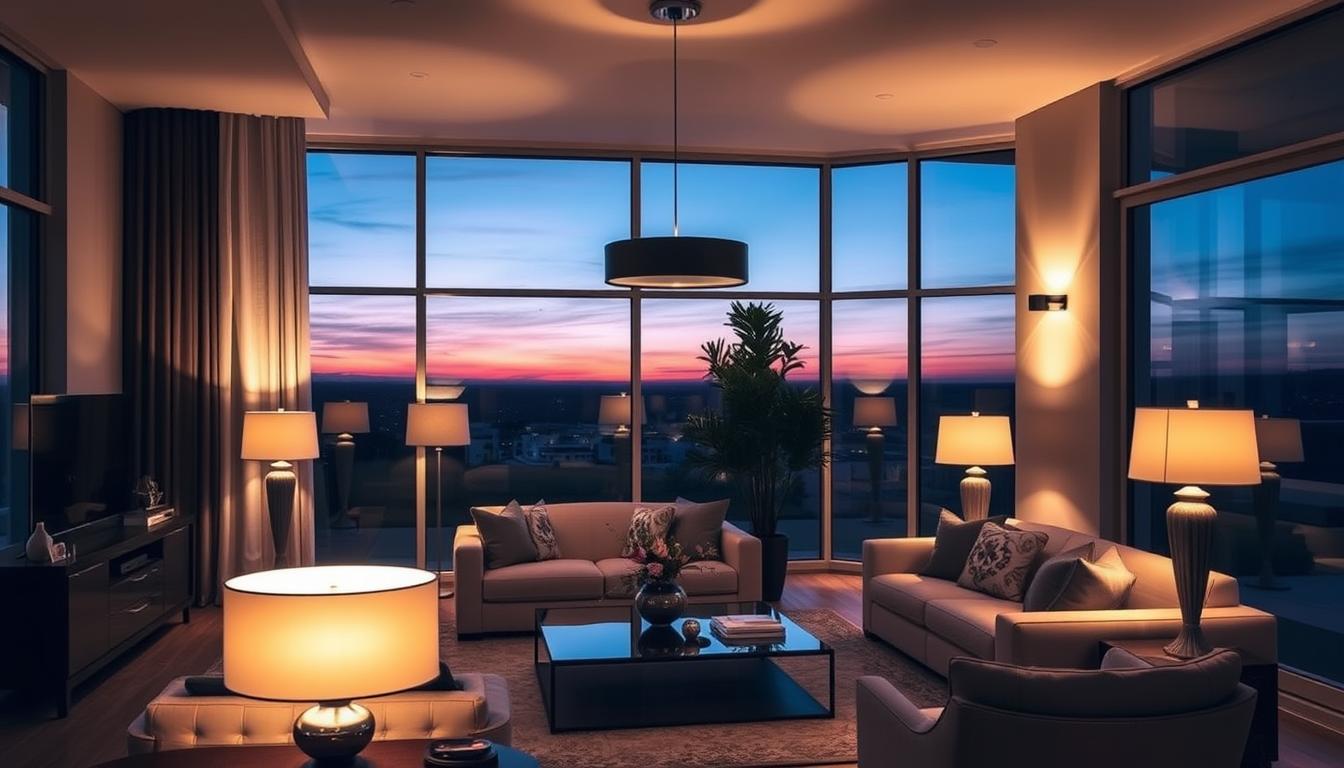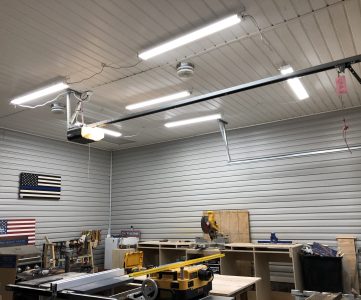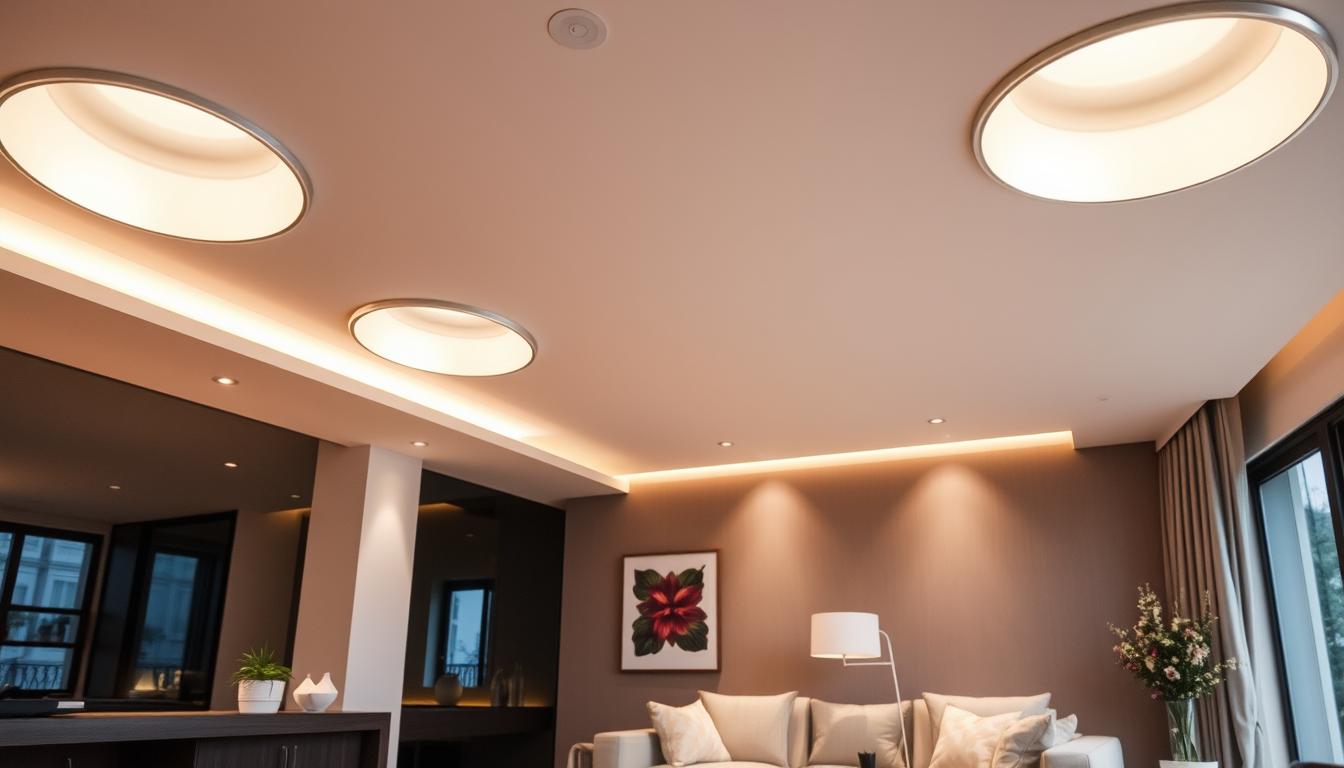Creating the perfect ambiance in your home starts with a good lighting plan. A well-thought-out room layout is key. It sets the mood for each space. By focusing on each room’s needs, you can make your home feel welcoming and comfortable.
A balanced lighting design and room layout are crucial. They make your space both beautiful and useful. Whether you want a cozy reading area or a bright kitchen, the right plan can help.
Introduction to Lighting Design and Room Layout
With some planning and creativity, you can make your space reflect your style and needs. Think about ambient and task lighting when designing. By focusing on these, you can create a home that looks great and works well.
Key Takeaways
- A well-planned lighting design is essential for creating the perfect ambiance in your home.
- Effective room layout can make a big difference in the overall atmosphere and functionality of your space.
- Lighting design and room layout should be considered together to achieve the perfect balance of form and function.
- Ambient lighting can help create a cozy and inviting atmosphere in your home.
- Task lighting can help you accomplish specific tasks, such as reading or cooking.
- A good lighting design and room layout can help you create a space that is both beautiful and functional.
Understanding the Basics of Light Planning
Creating a cohesive lighting plan is key to setting a room’s mood and ambiance. The right light placement can transform a space. It’s vital to grasp the basics of light planning for the desired effect.
Light placement is crucial for mood lighting. It greatly affects a room’s feel. A good lighting plan balances ambient, task, and accent lighting.
The Importance of Color Temperature
Color temperature is a big deal in light planning. It can change a room’s mood and ambiance. Warm white light makes a space cozy and inviting. Cool white light makes it brighter and more energizing.
Light Intensity and Distribution
Light intensity and distribution matter a lot in light planning. The right intensity makes a room feel spacious and comfortable. Poor distribution can lead to harsh shadows and unflattering light.
Essential Tools and Equipment for Home Lighting Design
For home lighting design, the right tools and equipment are key. Ambient light sets the mood and atmosphere of a room. To get the perfect feel, you need to mix different lighting types, like task lighting for specific areas or tasks.
A good lighting plan includes various fixtures, like table lamps, floor lamps, and overhead lights. These can offer both ambient light and task lighting, based on where and how they’re set up. For instance, a table lamp can light up a reading area while adding to the room’s overall ambient light.
- Light intensity and distribution
- Color temperature and tone
- Fixture style and design
Choosing and placing lighting fixtures wisely lets homeowners create a space that looks good and works well. It meets their needs and improves their lifestyle.
Layering light is key to creating a beautiful and functional space. By combining different types of lighting, including task lighting and ambient light, homeowners can create a unique and inviting atmosphere that enhances their daily lives.
Creating Your Kitchen Lighting Strategy
Creating a good kitchen lighting plan is key to a functional and beautiful space. It’s about mixing different lighting types and designs for the perfect feel. A good plan includes task, ambient, and decorative lighting for a warm, inviting kitchen.
Think about the different lighting layers for your kitchen. You’ll need task lighting for areas like countertops and sinks. Ambient lighting adds a warm glow. And decorative lighting brings visual interest. This mix makes your kitchen both useful and stunning.
Counter and Task Lighting
Counter and task lighting are vital for kitchen tasks like food prep and cooking. Options like under-cabinet lights, pendant lights, and recessed lights work well. They make your kitchen both functional and stylish.
Dining Area Illumination
The dining area in your kitchen needs special lighting. Table lamps or a chandelier can create a cozy feel and enough light for meals. Think about the best lighting for your dining area in your kitchen plan.
Important things to consider in kitchen lighting design include:
- Layering different types of lighting for a functional and beautiful space
- Using lighting layers for a warm, inviting feel
- Combining task, ambient, and decorative lighting for a complete design
Decorative Lighting Features
Decorative lighting adds personality to your kitchen and creates a unique vibe. Options like string lights, LED lights, and glass pendant lights are popular. Choose decorative lights that fit your kitchen’s design and overall feel.
Living Room Light Planning Made Simple
Creating a warm and inviting living room starts with room layout. The way you arrange furniture greatly affects the room’s feel. Use table lamps, floor lamps, and string lights to add a cozy glow.
Here are some tips for planning your living room lighting:
- Think about the room’s size and the activities you’ll do there.
- Plan your room layout to create different zones with lighting.
- Consider how light placement affects the room’s mood.
A well-thought-out lighting plan can transform your living room. By focusing on room layout and light placement, you can make a space that’s both useful and stunning.
A good lighting plan can make a room feel more welcoming and inviting. It’s all about finding the right balance between form and function.
| Lighting Type | Description |
|---|---|
| Table Lamps | Great for task lighting and adding a touch of warmth to a room. |
| Floor Lamps | Perfect for ambient lighting and creating a cozy atmosphere. |
| String Lights | Can add a touch of whimsy and warmth to a room. |
Bedroom Lighting for Comfort and Functionality
Lighting is key to a cozy bedroom. A good lighting plan changes the room’s feel. It’s all about mood lighting and task lighting.
Using both mood lighting and task lighting makes the room both comfy and useful. Table lamps or floor lamps are great for reading or working. String lights or dimmable overhead lights add a relaxing touch.
Reading and Task Areas
Having special spots for reading and tasks is important. A cozy reading nook with the right light is perfect for unwinding. Mix task lighting and mood lighting for a welcoming feel.
Ambient Lighting Solutions
Ambient lighting makes the bedroom calm. Think about dimmable overhead lights or string lights for a soft glow. This kind of light reduces eye strain and helps you relax, making sleep easier.
| Lighting Type | Benefits |
|---|---|
| Task Lighting | Provides focused light for reading and tasks |
| Mood Lighting | Creates a relaxing and inviting atmosphere |
| Ambient Lighting | Provides soft, warm glow for relaxation |
Bathroom Lighting Essentials
When it comes to bathroom lighting, ambient light is key for a cozy feel. A good lighting plan can really change the room’s vibe. It’s all about lighting layers, which include overhead, task, and accent lights.
Ambient light comes from recessed lights, sconces, or LED lights. These can be placed to give a soft, warm light over the whole room. For instance, recessed lights above the shower or bathtub add depth and interest.
Some top picks for bathroom lighting include:
- Recessed lights for ambient light
- Sconces for task lighting
- LED lights for accent lighting
Using these lighting layers and fixtures makes your bathroom both useful and pretty.
The secret to great bathroom lighting is mixing ambient light with task and accent lights. This creates a space that’s both useful and lovely. It makes your daily routine more enjoyable and calming.
Home Office Lighting for Productivity
Lighting is key in a home office for both productivity and comfort. A smart room layout can make the most of natural light and cut down on distractions. Think about the tasks you’ll do in your office and design your lighting to fit those needs.
Task lighting is important for focused work like reading, writing, and computer use. Use desk lamps, under-cabinet lights, or pendant lights for this. Ambient lighting, on the other hand, lights up the whole room. You can use overhead lights, floor lamps, or table lamps for this.
Desk and Computer Area Lighting
Place your computer and desk to avoid glare from overhead lights. A desk lamp with an adjustable arm can help direct light where you need it.
Video Conference Lighting Setup
For video calls, you need good lighting on your face and a neutral background. Place your light source in front of you. A ring light or softbox can help avoid harsh shadows.
Reducing Eye Strain Through Proper Lighting
Good lighting can reduce eye strain and make your office more comfortable. Use lights with a high color rendering index (CRI) for natural-looking colors. By following these tips, you can make your office both useful and nice to look at. Your lighting design will match your room layout perfectly.
Outdoor and Entryway Light Planning
When planning outdoor and entryway lighting, light placement is key. It makes your space welcoming and safe. The right lights set the mood for a cozy outdoor experience. By using mood lighting, you can make your outdoor area unique and stylish.
Here are some important things to think about:
- Security lighting: install motion-sensitive lights or floodlights to light up entry points and scare off intruders.
- Landscape lighting: use spotlights or pathway lights to show off your garden and make it look great.
- Porch and pathway illumination: add pendant lights or string lights to make your porch and walkways warm and welcoming.
By thinking about light placement and mood lighting, you can make your outdoor area both useful and beautiful. Make sure the light isn’t too harsh or bright. Also, choose energy-saving lights to help the planet.
A good outdoor and entryway lighting plan can make your home’s outside look better and work better. It also keeps your home safe and secure. By focusing on light placement and mood lighting, you can make a unique and welcoming outdoor space.
| Lighting Type | Purpose | Benefits |
|---|---|---|
| Security Lighting | Deter intruders and illuminate entry points | Enhanced safety and security |
| Landscape Lighting | Highlight garden features and create ambiance | Visually appealing landscape and increased curb appeal |
| Porch and Pathway Illumination | Create a warm and inviting ambiance | Enhanced outdoor living experience and safety |
Smart Lighting Integration and Control Systems
Smart lighting systems are key to a functional and energy-saving home. They let homeowners easily adjust task lighting and ambient light levels. This creates the perfect light balance in every room.
These systems can be controlled wirelessly or through a wired connection. Homeowners can change lighting levels, colors, and schedules as needed. For instance, they can make the living room warm and cozy by adjusting the ambient light and color.
Smart lighting offers many benefits:
- It saves energy by turning off lights when not needed.
- It’s convenient, letting homeowners control lights from anywhere.
- It allows for customized lighting scenes and schedules, making each room unique.
Adding smart lighting systems to homes makes them more comfortable, convenient, and energy-efficient. Homeowners can control task lighting and ambient light levels. This creates a balanced light and shade in every room, improving the home’s ambiance and function.
Conclusion: Bringing Your Lighting Plan Together
Creating a good lighting design for your home is all about planning. It’s about balancing task, ambient, and accent lighting. This balance makes your space look good and work well for you.
Lighting design is like art, where you can have fun and try new things. Mix different light sources and adjust colors and brightness. This way, you can make any room feel welcoming and useful.




